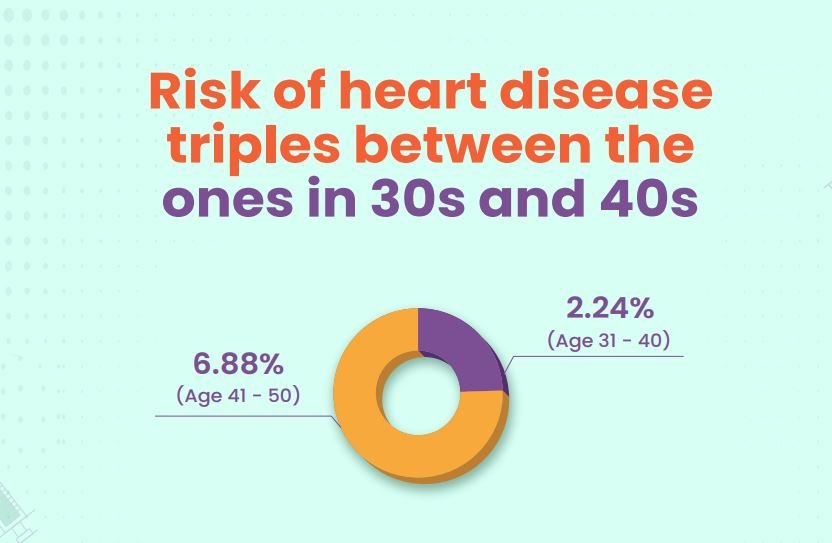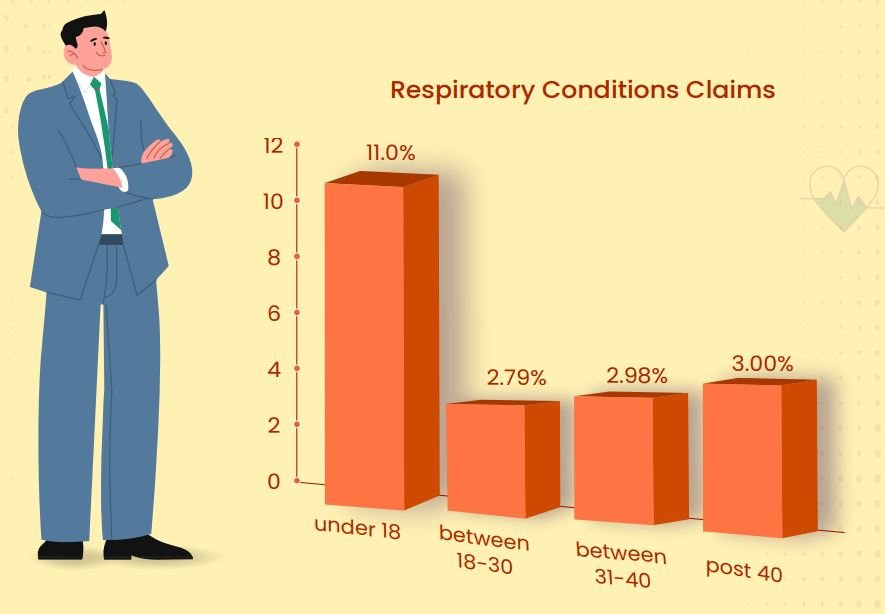Rising Health Risks in India: Heart Disease, Respiratory Conditions, and Soaring Healthcare Costs
According to ACKO India Health Report 2024, India faces a growing health crisis, with alarming rates of heart disease, respiratory conditions, and other serious illnesses. With healthcare costs skyrocketing and insurance coverage lacking, many Indians are at risk of financial hardship due to medical emergencies. This article explores the key trends in India’s health landscape and offers insights into the major diseases affecting Indians today.

Heart Disease Risk Triples Between Ages 30 and 40
The risk of heart disease in India escalates significantly as people age. The rate of hospitalizations for heart-related conditions triples between the ages of 31 and 40 (2.24%) and 41 and 50 (6.88%). Indians are also 20-50% more likely to suffer from coronary artery disease (CAD) compared to other populations, driven by poor dietary habits, sedentary lifestyles, and genetic factors.

According to the Global Burden of Disease Study, heart disease is the leading cause of death among Indian women, accounting for 18% of all female deaths. This figure surpasses deaths from breast cancer and other cancers combined.
Heart Disease Claims Spike in Kolkata and Mumbai
Kolkata and Mumbai lead the country in terms of claims related to heart conditions like heart attacks and strokes. Chennai and Pune also see heart-related claims well above the national average. The average size of health insurance claims for these conditions has increased by 11.35%—a reflection of rising healthcare costs and medical inflation.
- 3x increase in heart disease risk between ages 31-40 and 41-50.
- 18% of female deaths in India are due to heart disease.
- 11.35% rise in claim size for heart-related conditions.
- 30% of colon cancer patients in India are under age 50.
- 62% of healthcare expenses are paid out of pocket.
- 69% of maternity claims are for C-sections.
Tumor and Cancer Risks Surge After 40
After the age of 40, the risk of developing tumors, both cancerous and non-cancerous, rises sharply. The rate of hospitalization due to neoplasms increases by 2.8 times between the ages of 31-40 (3.81%) and 41-50 (10.61%). India has also seen a concerning trend in younger patients being diagnosed with cancer. The average age for breast cancer diagnosis in India is 52, compared to 63 in Western countries. For lung cancer, the average age is 59, significantly younger than the Western average of 70.
Respiratory Conditions Hit Children Under 18 the Hardest
Children under 18 are most prone to respiratory diseases in India, making up more than 11% of all medical claims. This rate drops significantly in adulthood, with only 2.98% of respiratory-related claims between ages 31-40. Even after age 40, the rate remains stable around 3%.

Delhi Tops Kidney Disease Claims
Delhi NCR has the highest number of claims related to kidney diseases, followed by Kochi, Secunderabad, Bengaluru, and Jaipur. Most patients filing kidney-related claims are in their late 40s, with the average age being 47. The rising cases of kidney disease underline the need for better public health awareness and early diagnosis.
Cancer Cases Expected to Rise 13% by 2025
Cancer is expected to see a 13% increase in cases from 2020 to 2025. This alarming statistic positions India to soon become the global capital of cancer cases. Colon cancer, in particular, is affecting younger populations, with nearly 30% of Indian colon cancer patients being under 50.
The C-Section Surge in India

A staggering 69% of maternity claims in India are related to C-section deliveries. Interestingly, there is a marked difference between public and private hospitals, with C-section rates in government hospitals accounting for just 22% of births, compared to much higher numbers in private institutions.
Indians Face Financial Crisis from Healthcare Costs
Healthcare in India remains unaffordable for many. Around 62% of healthcare expenses are paid out-of-pocket, and 23% of hospitalizations are financed through borrowings. On average, Indian households spend 7.9% of their annual income on healthcare. Unfortunately, 82% of urban households lack any form of health insurance, making them vulnerable to financial ruin in the event of a medical emergency.








